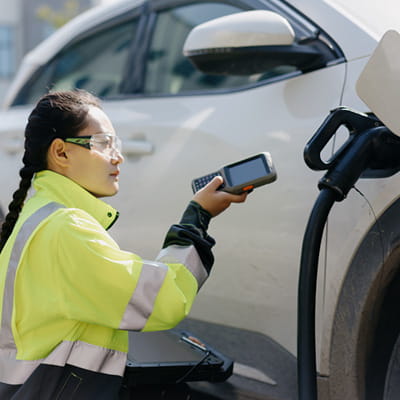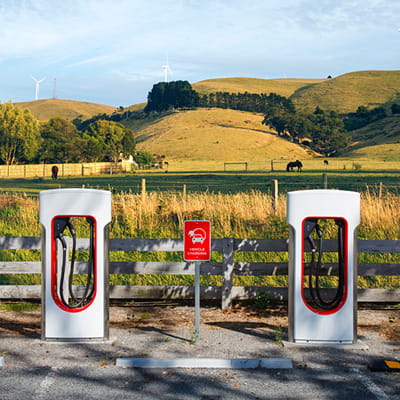The road to EV: How to transition your business fleet to electric vehicles
- The market for electric vehicles in Australia is on the rise, with a larger choice of EV models and variants available across personal and commercial vehicle classes
- For businesses, transitioning to an electric vehicle fleet is more complex than selecting the actual vehicle
- Establishing new processes and targets, charging infrastructure and driver training are just some essential components of a successful EV transition strategy
With business fleets accounting for almost half of all passenger vehicles sold in Australia,1 the market for transitioning to an EV fleet is sizeable.
Electric commercial and heavy vehicles options have expanded in recent times. As at June 2023, 44 electric truck, commercial van and bus models were the on the market2, up from 36 in September 20223 – that’s a 22% increase in less than a year.
Ken Arthur and Robert DiPierdomenico spend a great deal of time with business fleet operators as QBE’s National Risk Managers of Commercial Motor Risk Solutions, and are seeing businesses approach the transition to EVs with careful consideration.
“In the conversations we have with customers, most are positive about the proposition of transitioning to an electric fleet,” says Arthur.
“However, there’s a desire to get all of the kinks ironed out before jumping in – whether that be challenges with charging infrastructure or understanding which models will work best for the needs of their business.”
In this guide, we’ll unpack the process of transitioning to an EV fleet, including the steps you’ll need to take to get your business EV ready.

Set transition and emissions targets for your EV fleet
Reducing greenhouse gas emissions is a contributing factor for many business owners when deciding to introduce EVs into their fleet.
To understand the impact of your new EV fleet, you’ll need to set clear goals and targets in consultation with a sustainability expert or your in-house sustainability team.
While the targets you set will be determined by the size of your fleet and your business objectives, some key considerations may include:
- what percentage of the fleet will be electric (short term and long term)
- the percentage reduction in tailpipe emissions
- a specified date for eligible drivers to be allocated an EV
- a low-carbon fleet by a specified date
Establish EV fleet policies, guidelines and processes
New policies, guidelines and processes will need to be established prior to transitioning your fleet to EVs. Some key considerations include:
- How will the business run procurement?
- How will EVs be introduced to the business?
- Where and when will the vehicles be charged, and who is responsible for charging?
- What’s the process for reporting on and assessing the impact – both environmentally and on the business?
- What new safety protocols are needed for drivers?
- How are we going to train current and new employees?
- What happens if an employee has the full-time use of an EV and needs a charging station at home?
- What is the process if they then exit the business?
- How do we record business versus personal travel?
Choose the right EV model for your business
Choosing the right EV models and variants for your business involves selecting vehicles that meet your specific needs. This decision should take into account factors such as minimum range requirements, charging needs, and the reputation of the chosen vehicles and manufacturers.
“Range is a particularly important consideration in Australia, due to the large distances drivers may need to travel between charging stations,” says DiPierdomenico.
Thought will also need to be given to whether you transition to battery powered vehicles (BEVs), plug-in hybrid electric vehicles (PHEVs), or a combination of both.
Fleet size is another an important consideration. Unless your fleet includes only a handful of vehicles, it likely won’t be feasible to transition all vehicles to EVs at once.
“Those with larger fleets may find it beneficial to run a pilot transition with a small number of EVs, allowing time to work through any unforeseen challenges with new models a smaller scale,” says DiPierdomenico.
Understand driver behaviour and EV eligibility
To understand your EV fleet requirements, you can create an eligibility matrix to help identify drivers who may continue to require an internal combustion engine (ICE) vehicle.
Range is the primary factor here – an employee that uses a vehicle occasionally throughout the day in a city will have different requirements to an employee who spends the majority of their time driving in regional or rural locations.
To gain insights into driver behaviour, telematic systems should also be installed on each EV.
“Data is crucial to understand driving habits and patterns. It can help drivers get more from their EVs and can also inform business decisions, such as placement of charging stations,” says Arthur.
Telematic data is also important when it comes to assessing driver behaviour, which we’ll touch on shortly.

Understand your EV charging requirements and logistics
Charging is one of the most significant challenges to navigate when introducing EVs into a business.
Understanding charging requirements is vital to the success of the transition. Key considerations include:
- How often will each vehicle be charged?
- Where will they be charged?
- Who is responsible for charging?
- What happens if a charging station is unavailable?
Creating governance documents that detail requirements and expectations will contribute to a successful transition.
Establish an EV charging strategy
There are three ways vehicles can be charged – on-site, at public charging facilities or at home – each of which require specific considerations before introducing an EV fleet.
While installing on-site charging stations is an ideal solution, it comes with its unique challenges. Businesses, especially those renting premises, should consider the future location of these stations. Factors like lease duration and potential impacts of severe weather events, such as bushfires or floods, should be carefully evaluated when planning for on-site charging infrastructure.
Driver induction and education
EVs operate differently to ICE vehicles and drivers should receive education on how to operate them safely and effectively before getting behind the wheel.
In addition, by using telematic data, you can understand driver behaviour and identify changes to driving habits that can significantly reduce risk – ultimately leading to more time on the road, less downtime, and potentially fewer insurance claims.
EV transition advice from the experts
QBE’s Commercial Motor Risk team works with businesses across Australia and can help your business transition to an EV fleet. To find out more, visit our Fleet Risk Management Solutions page.
1 ARENA article – Origin aims to accelerate EV fleet take-up
2 Electric Vehicle Council, State of Electric Vehicles report – July 2023
3 Electric Vehicle Council, State of Electric Vehicles report – October 2022




